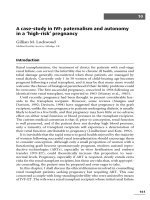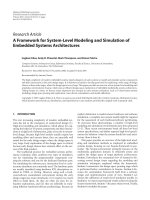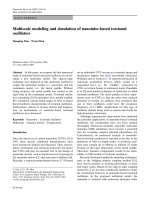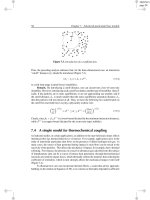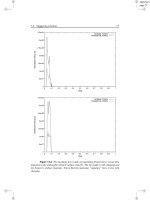Case Study in Financial Modeling and Simulation of a Forestry Investment potx
Bạn đang xem bản rút gọn của tài liệu. Xem và tải ngay bản đầy đủ của tài liệu tại đây (842.24 KB, 18 trang )
1
Chapter 10: Case Study
in Financial Modeling
and Simulation of a
Forestry Investment
Investment in forestry as an
example of capital budgeting
techniques applied to long
term projects.
2
Introduction
Forestry provides two types of long
term benefits:-
Wood benefits;
timber, poles, thinnings
Non-Wood benefits;
environmental protection,
wildlife habitat,
land restoration,
recreational environment.
Both these benefits can span a lifetime
of over 50 years.
3
Cash Flow Structure
General for Projects Particular to Forestry
initial cash outlay long term maintenance
inflows from sale of product timed on-going outlays:-
thinnings, maintenance,
income- poles or timber?
income – time of harvest?
Cash Flow Forecasting
Cash flow prediction over a long horizon is difficult.
Investment Evaluation Criteria
The Land Expectation Value(LEV) model is applied
in preference to the NPV model.
4
Key Parameters in
Forestry Models
Establishment:- land, land preparation,
plant stock, planting, watering.
Maintenance:- weed control, fertilizing,
pruning and thinning, fire and pest
protection.
Inflows:-
wood; commercial thinning, final harvest
non-wood; flora gathering, recreation,
land renewal.
Required rate of return.
5
Forest Yield Factors
Wood growth is measured by the
MAI: Mean Annual Increment;
‘the annual increase in cubic meters of
harvestable timber per hectare’.
The MAI is influenced by-
relevant rainfall, soil fertility,
species mixture, planting régime,
crop protection.
Final monetary payoff is influenced by-
harvest age, species type, timber price.
6
Forestry Risks 1
Establishment:
drought, weeds
Production:
storm, fire,
pests and diseases,
unsuitable species,
collateral damage at harvest.
7
Forestry Risks 2
Timber return: inappropriate
pruning and thinning, poor growth,
timber usage and fashion changes.
Sovereign risk: regulatory changes,
taxation changes, uncertain harvest
rights.
8
Predicting Cash Flows 1
The key growth indicator is the
Mean Annual Increment.
0 20 50+
Years of growth
9
Predicting Cash Flows 2
The Delphi method may be used to
forecast the MAI, costs, and sales
incomes.
10
Predicting Cash Flows 3
Particular long-term data for native
species is difficult to estimate.
11
Solving the Model
12
Solving the Model
13
Solving the Model
Define and predict the long
term benefits
14
Solving the Model
Define and predict the long
term benefits
Asses the risks
15
Solving the Model
Define and predict the long
term benefits
Asses the risks
Estimate
the cash
flows
16
Solving the Model
Define and predict the long
term benefits
Asses the risks
Estimate
the cash
flows
NPV
LEV
17
Sensitivity Analysis
Variables:
stumpage price
yield - thinning
yield - poles
yield - timber
weed control
pruning.
Scenario Analysis
Harvest at Yr 34,
or Yr 60
Monte Carlo
Analysis of
sensitive
variables.
18
Forestry Modeling
Forestry projects are long term.
Costs and benefits are difficult to
predict.
Growth risks and product types are
particular to forestry.
Modeling helps to analyze the
forecast values.

